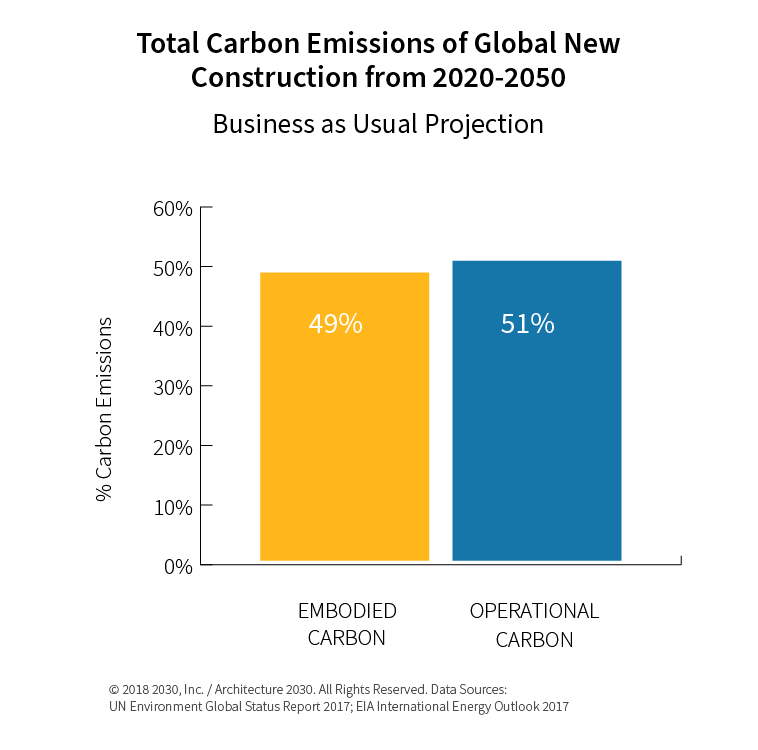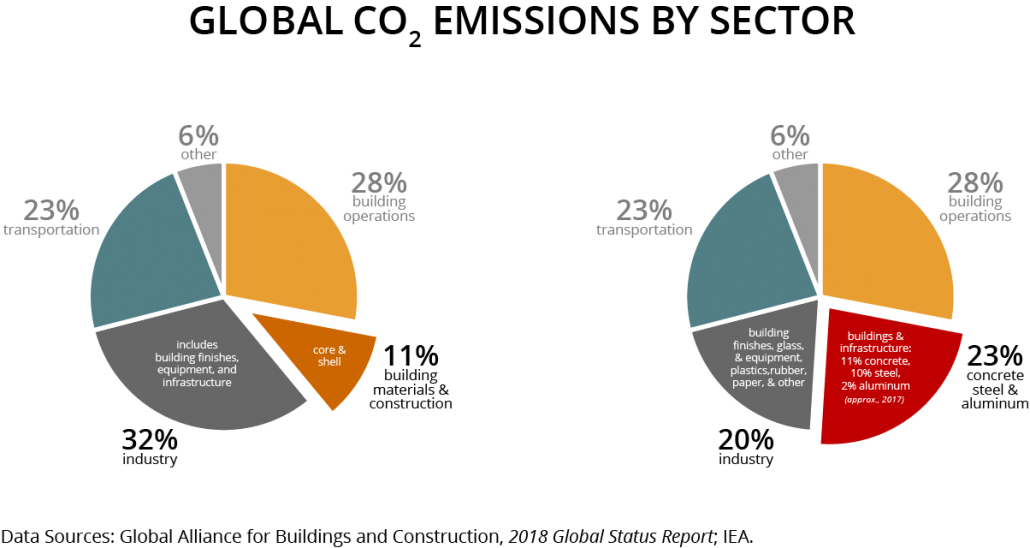Alyssa recently published an article in Forum, the magazine of AIA New Hampshire. To see the article, click here, or read the text as reprinted below.
THE CARBON IMPERATIVE
October 10, 2021
Annually, the embodied carbon of buildings is responsible for 11% of global GHG emissions.
The Imperatives outlined by AIA in the 2025 Strategic Plan are bold, visionary, and require the determination and participation of AIA members throughout the country. In New Hampshire, we are proud to have been at the forefront of much of the sustainability movement over the last twenty years. As a chapter, we have structured much of our programming around the 2030 Challenge and worked to make sure that management of energy use intensity is a cornerstone of our practice.

The World Green Building Council defines embodied carbon as, “emissions as a result of material manufacturing and construction processes, building maintenance and renovation, and when buildings are demolished.”
But over the past few years, a new urgency has emerged; an issue that was right in front of us and yet obscured by our focus on energy use. The energy required to produce the materials that we build with – the very building blocks of the design and construction professions – has a tremendous impact as well. Emission of carbon dioxide spans from extraction and manufacturing processes; to building construction processes and subsequent renovations; and ultimately to when buildings are demolished. Each step in the process has a carbon impact that has heretofore been difficult for architects to quantify.
The study of embodied carbon has been accelerating over the last decade, however. Much of the research has been the organization now known as the Carbon Leadership Forum, a research and advocacy collective led by Kate Simeon, AIA, the CLF Executive Director and Professor and Professor and Chair of the Department of Architecture at the University of Washington. The CLF mission is “to eliminate embodied carbon in buildings and infrastructure by inspiring innovation and spurring change through collective action.”

2030 CHALLENGE FOR EMBODIED CARBON: The embodied carbon emissions from all new buildings, infrastructure, and associated materials must be reduced by 65% by 2030, and zero by 2040.
Why is concern about embodied carbon all of a sudden at the forefront of the conversation? The recognition that building materials and construction alone account for 11 percent of all global emissions sheds new light on our industry and its contribution to greenhouse gas emissions. New tools have made it easier to identify and track life cycle impact, and their widespread use is shifting the industry. One such online tool, nonprofit Building Transparency’s EC3, was launched in 2019 and has drawn widespread attention due to its accessibility and ease of use. EC3 allows designers to quickly compare products and determine their overall impact on a range of metrics.
Environmental product declarations (EPDs) are independently-verified documents based on international standards that report the environmental impacts of a product. These declarations can be used to track supply chain-specific product data and compare products if the products are functionally equivalent and have aligned scopes. -Carbon Leadership Forum
My own experience in researching embodied carbon impact, exploring the tools available to us, and shifting our practice has been positive. In the past, despite designing for minimal energy use or striving for net-zero, we haven’t always had the power to ensure our desired outcome. We can specify high-performance envelope materials and project target energy usage, but the owner’s budget decisions, poor construction quality and/or post-occupancy use patterns all affect the overall operational carbon. When it comes to embodied carbon, often we are able to reduce CO2 without affecting performance or cost at all; it’s a matter of knowing your materials and selecting those with the least impact. As a firm, we feel more empowered, and therefore hopeful.
As we change the way that we select and specify materials, we exert a powerful market force. Innovative companies, such as Interface, have been at the forefront of embodied carbon research for years and have both challenged and partnered with building owners, designers, and manufacturers to improve performance and even produce a carbon-positive product line. On the other hand, I asked a product representative earlier this year if her product carried an Environmental Product Declaration and she said, “I don’t know what that is, but I’ll find out.” When she came into our office a few months later, she said, “Wow – I had never heard of this few months ago, but it’s come up every week now.”
As manufacturers see architects and engineers shift to low-carbon alternatives, our materials will improve. But we needn’t wait. The time for change is now, and as architects in New Hampshire, we need to lead this shift with our clients and our design teams. Once carbon accounting is part of your practice, it becomes second nature to the design process; the first step is learning how to make the shift.
HOW CAN WE IMPROVE OUR PRACTICE?
Educate your team
-
- The Boston Society of Architects (BSA) produced a series of webinars in 2020: Embodied Carbon 101. The videos are available on the BSA website and may be self-reported for CEU credit.
- The CLF resource library (org/resource-library) is an excellent source for articles and books for further research.
Explore new tools
- Carbon Smart Materials Palette (materialspalette.org) and the 2030 Palette (2030palette.org) by Architecture 2030 both provide big picture information about carbon reduction strategies focused on the most impactful materials and low-carbon alternatives.
- Life Cycle Assessment plug-ins for Revit, such as Tally, One-Click LCA, Athena, and others help guide major decisions in the early design phases.
- Building Transparency’s EC3 tool carries data on thousands of individual products; it is best used when determining which particular materials to specify.
Shift the conversation with vendors
- The most effective way to shift the industry is driving it with our dollars; in the case of architects, our “buying power” is in how we select and specify materials. Ask for an Environmental Product Declaration (EPD) for all products you specify.
Be part of the discussion
- The Carbon Leadership Forum offers a robust online community section on their website (carbonleadershipforum.org/online-community) where resources are shared and discussed.
- CLF’s Boston Hub is also a Knowledge Community of the BSA; the group meets bimonthly via Zoom.
- Interested in more programming around embodied carbon for AIANH? Connect with the Committee on the Environment (COTE). Email: [email protected] for more details.